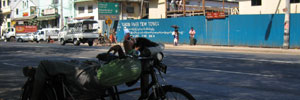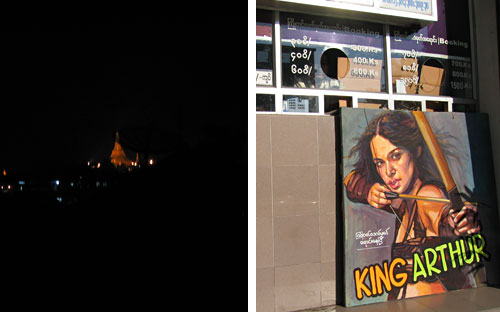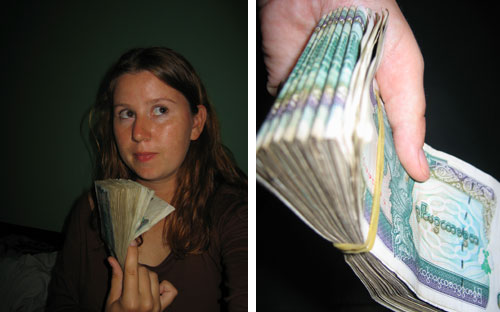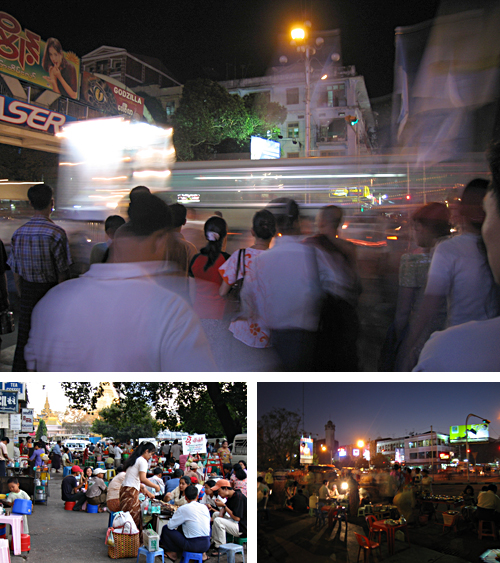
The area I was staying in Bangkok was a backpacker’s haven. The streets were littered with internet cafes, CD sellers, tailors and restaurants serving “American Breakfast.” Because of this, I was able to book a spot on a bus to the airport for a lot cheaper than a taxi. After checking out of my hotel I sat down in the restaurant downstairs on the street and waited for my bus. And I waited. I waited 45 minutes before I started to worry. One thing that traveling in 33 countries has taught me is patience. Finally, I flagged a taxi to take me to the airport, worried that I would miss my flight. I had heard horror stories about the traffic and, looking at my watch I started to curse my patience. Even the taxi driver yelled at me for waiting so long.
The flight over was quick, and amazingly I was served a steaming hot entree which took up most of my time on the flight. Passing through customs was easy and the guard refused to let me declare my laptop. I had heard that there can be problems with higher-end electronics (the government thinks you’re a spy) and it was best to declare them. I don’t know if things have changed so much since I had heard that advice or if the guard was just lazy, but my beautiful white iBook stayed in my bag. I eyed my fellow passengers in baggage claim, trying to decide the best candidate to bum a ride with. No one was very friendly so I wandered outside alone, passing by the empty FEC exchange booths. Up until a few years ago foreigners were required to exchange $500 USD worth of money into FEC notes. They were basically like certificates you could exchange for goods in the tourist sector, mainly hotels. The practice has been discontinued and anyone who changes money at an official money changing station is a fool because the official exchange rate is almost half of the black market rate. Standing outside I asked a girl about my age what a good price for a taxi was and she offered me a ride. She worked for a NGO and was being picked up by her driver–sounded good to me!
I had chosen a hotel popular for it’s “huge breakfast” because I knew I would find a lot of other travelers to talk to and get information from there. It turns out that a “huge breakfast” mostly appeals to Germans. In any case, there were no small rooms available and I ended up with a three bed room with it’s own bathroom for $10 on the 7th floor. The 7th floor sounds nice, but in reality it meant climbing 7 flights of stairs (the first floor is what Americans call the second floor–Myanmar was ruled by the British and retains some of their customs) with my backpack. The floor above me housed a kitchen and the top two floors were common areas for breakfast and socializing. The owners had built two rooms on the roof out of sheet metal. These rooms had no electricity and literally holes cut out for windows but one of them faced the Shwedagon Paya which is light up at night. I soon learned that lighting the Shwedigon is a priority of the Burmese government because every time our electricity went out the Shwedigon stood out, golden as could be. I soon got used to the frequent power outages, and although I cursed every flight of stairs I climbed I was glad there was no elevator. I don’t think you could pay me to get into an elevator in Myanmar.

The Shwedagon Paya at night from the hotel roof // Hand-painted movie poster
My first day in Yangon was spent wandering around, admiring the crumbling British colonial architecture and figuring out how things worked. One main project I had was to get money. If you are not familiar with Myanmar, than you might find a short history lesson of interest. If you’re over 40 and aren’t familiar with Myanmar that’s probably because you know it as Burma. The Burmar are an ethnic group in central Myanmar who hold a lot of the power but the country may have as many as 100 other distinct ethnic groups who are often persecuted. Because many countries don’t recognize the current military dictatorship of Myanmar it is oftentimes still referred to as Burma. The U.S. government has sanctions against Myanmar because of it’s deplorable human rights record. What this means for me is that there are no international ATMs in the country. Also, only a handful of businesses are allowed to process credit cards (which are routed through Thailand) and they are often hotels that cost hundreds of dollars per night–hardly within my budget. To top it off, traveler’s checks are also not accepted–American or otherwise. What it comes down to is cash. As a man once yelled at me in Kengtung, Myanmar, “The dollar is king!”
Watch short movies I took of Yangon here (Quicktime 248 kb) and here (Quicktime 432 kb).
After settling into my family-sized room I set off to get some kyat. When I entered Myanmar for the first time in January overland from Thailand I paid for and exchanged Thai Bhat. Because that part of the Shan State is so close to Thailand and relatively cut off from the rest of Myanmar they preferred bhat to dollars. But now I needed kyat, the local currency, for purchases under $3. I walked about 6 blocks to the busy market and wandered around looking for a honest-looking jewelry salesman. I picked my man and asked him if wanted some dollars. He took out his calculator and showed me the exchange rates for a 100 dollar bill and for anything else. Changing money in every other country I have ever been to has been the opposite–they want small bills. But in Myanmar you get a better exchange rate for 100 dollar bills. Knowing this I had purposely taken large bills out of a bank in Thailand along with smaller bills to pay for hotels. In exchange for my 1 100 dollar bill I was handed an inch high stack of 1,000 kyat notes. I counted my notes and walked back to the hotel with a bag of money and soon realized that the smallest note I had was often times too much for anyone to change.

Hey! I didn’t have a hairdryer for over 6 months // $100 in kyat
There were so many people out at night that I didn’t feel threatened at all walking around by myself. Around 6 pm the streets transformed around me. Although they were busy during the day they were bustling at night. Small restaurants set up along all of the sidewalks with their tiny stools. A lot of the food was Indian-influenced. While I was looking for something to eat all of a sudden the street was filled with people holding statues and singing. I assumed it was Buddhist but soon saw that the statues being carried were the Virgin Mary. You can watch a short clip of the procession by clicking here (Quicktime 568 kb). Myanmar was turning out to be the kind of place where you could suddenly find yourself walking in the middle of a Christian processional while eating an Indian Samosa.

Christian procession // Streetside “restaurants” by day and night
You can see the photos from Yangon in the gallery.